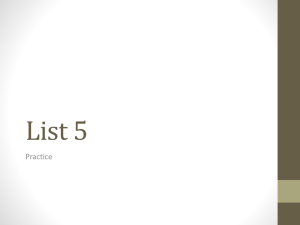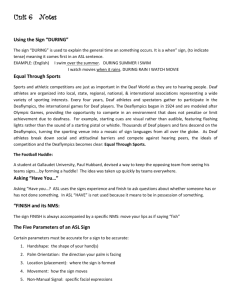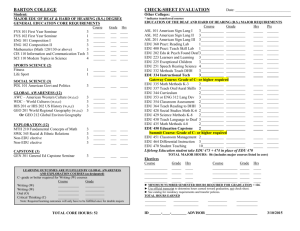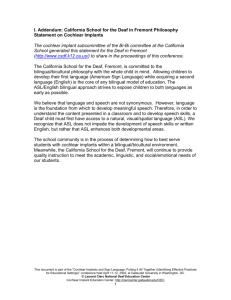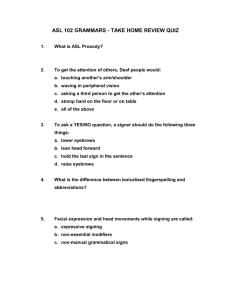Syllabus - Dartmouth College
advertisement
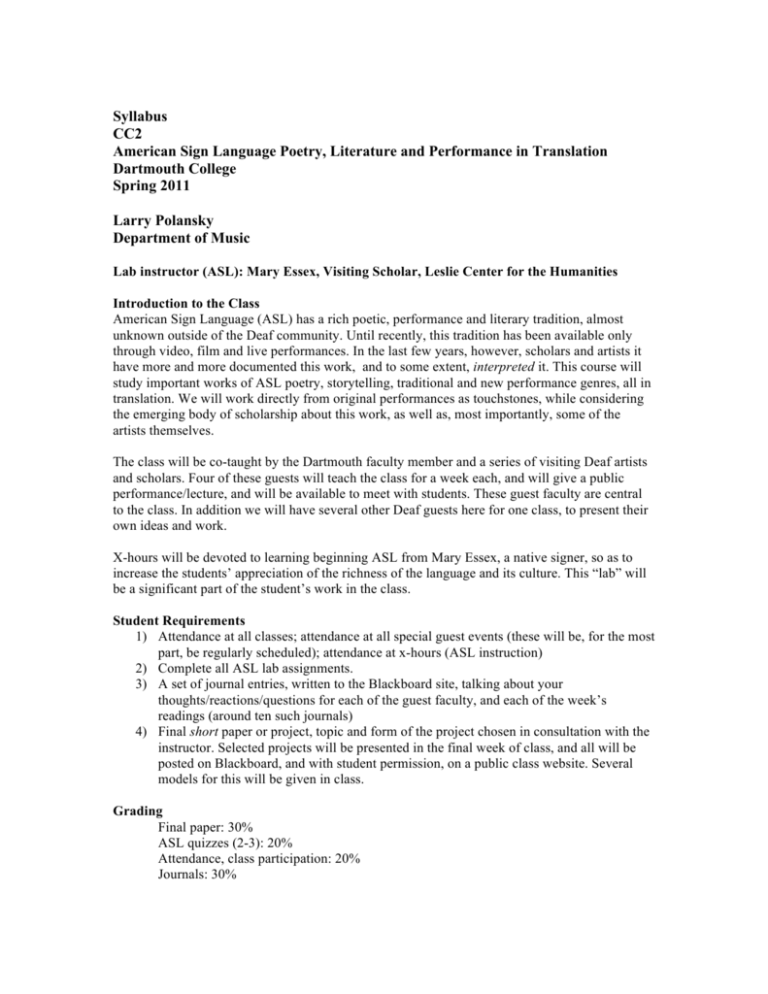
Syllabus CC2 American Sign Language Poetry, Literature and Performance in Translation Dartmouth College Spring 2011 Larry Polansky Department of Music Lab instructor (ASL): Mary Essex, Visiting Scholar, Leslie Center for the Humanities Introduction to the Class American Sign Language (ASL) has a rich poetic, performance and literary tradition, almost unknown outside of the Deaf community. Until recently, this tradition has been available only through video, film and live performances. In the last few years, however, scholars and artists it have more and more documented this work, and to some extent, interpreted it. This course will study important works of ASL poetry, storytelling, traditional and new performance genres, all in translation. We will work directly from original performances as touchstones, while considering the emerging body of scholarship about this work, as well as, most importantly, some of the artists themselves. The class will be co-taught by the Dartmouth faculty member and a series of visiting Deaf artists and scholars. Four of these guests will teach the class for a week each, and will give a public performance/lecture, and will be available to meet with students. These guest faculty are central to the class. In addition we will have several other Deaf guests here for one class, to present their own ideas and work. X-hours will be devoted to learning beginning ASL from Mary Essex, a native signer, so as to increase the students’ appreciation of the richness of the language and its culture. This “lab” will be a significant part of the student’s work in the class. Student Requirements 1) Attendance at all classes; attendance at all special guest events (these will be, for the most part, be regularly scheduled); attendance at x-hours (ASL instruction) 2) Complete all ASL lab assignments. 3) A set of journal entries, written to the Blackboard site, talking about your thoughts/reactions/questions for each of the guest faculty, and each of the week’s readings (around ten such journals) 4) Final short paper or project, topic and form of the project chosen in consultation with the instructor. Selected projects will be presented in the final week of class, and all will be posted on Blackboard, and with student permission, on a public class website. Several models for this will be given in class. Grading Final paper: 30% ASL quizzes (2-3): 20% Attendance, class participation: 20% Journals: 30% CoCo 2: ASL Poetry and Performance in Translation Dartmouth College, Spring 2011 Polansky 03/27/11 Required Texts Padden and Humphries, Deaf in America: Voices from a Culture Padden and Humphries, Inside Deaf Culture Bauman, Nelson, and Rose, eds., Signing the Body Poetic: Essays on American Sign Language Literature. (This book has a DVD, which should be watched with the individual reading assignments) Other texts will be put on reserve, and most video assignments will be on the course website (some might be on reserve in the Jones Media Center). 2 CoCo 2: ASL Poetry and Performance in Translation Dartmouth College, Spring 2011 Polansky 03/27/11 Class Schedule (all topics subject to change) WEEK 1 (March 29 (no class on Thursday, March 31st)) Introduction to the course; introduction to signed languages; a brief history of modern American Sign Language (ASL); the idea of ASL poetry Readings: Padden and Humphries, Deaf in America, Introduction, Chapters 1– 4 Bauman, et. al, Signing the Body Poetic, Introduction, Foreword, Chapter 1, Chapter 3, and Appendix A Bahan and Hoffmeister, A Journey into the Deaf-World, Chapter 4-5 (“Form and Function in ASL” and “Deaf Culture”) (on reserve) Belluggi, Ursula, “How Signs Express Complex Meanings,” in Baker, C. & R. Battison, Sign Language and the Deaf Community. (on reserve, and on Blackboard) Selected written poems and the introduction (Stremlau) from The Deaf Way II Anthology (Curtis Robbins, Raymond Luczak, Willie Conley and others; read freely) Sacks, Oliver. Seeing Voices. Chapter 1, “A Deaf World” Viewings: Associated DVD excerpts from Signing the Body Poetic In the Heart of the Hydrogen Jukebox” WEEK 2 (April 5–7) Guest faculty, Patrick Graybill, poet, translator, teacher, scholar WEEK 3: (April 12–14) More on Deaf culture, and introduction to the history of d/Deaf literature identity though “folk,” storytelling, theatrical, literary traditions. Readings: Bauman et. al, Signing the Body Poetic, Chapter 2 (Bahan), Chapter 3 (on ASL and film), Chapter 4 (Cynthia Peters on Deaf American Theater) Miles, Gestures Padden and Humphries, Inside Deaf Culture, Chapter 3–6 (on reserve) Peters, Cynthia, Deaf American Literature, Chapter 4, “The Oral Tradition…” Belluggi and Klima’s The Signs of Language (1979) (Ch. 14: “Poetry and Song in a Language without Sound”) (on reserve) Veditz, George, transl. by Carol Padden, “The Preservation of the Sign Language,” in Deaf World (on reserve and on Blackboard) Rutherford, Susan, A Study of American Deaf Folklore (on reserve) Viewings: NTD’s My Third Eye In class: Veditz, “The Preservation of the Language” In-class:Mary Beth Miller, “Star Spangled Banner” 3 versions (past, present, future); examples by Lentz and from Krauel films In class: Examples of handshape, number and classifier stories (Bahan and others) 3 CoCo 2: ASL Poetry and Performance in Translation Dartmouth College, Spring 2011 Polansky 03/27/11 WEEK 4: (April 19–21) Tuesday, April 19: Gilbert Eastman’s Epic Viewings: Eastman’s epic on DPN (Deaf President Now) (in Signing the Body Poetic) Readings: Bauman, et. al., Signing the Body Poetic, Chapter 9 (Kristen Harmon on Eastman’s “Epic”) Eastman, Gilbert, From Mime to Sign (selections, read freely, on reserve) Gannon, Jack, The Week the World Heard Gallaudet (whole book, on reserve) Sacks, Oliver, Seeing Voices, Chapter 3, “The Revolution of the Deaf” (Week 4) Thursday, April 21: Guest faculty, Janet Marcous, Deaf/Blind activist and teacher WEEK 5: (April 26–28) Contemporary ASL artists, interpreting music in different ways, blurring the distinctions between theatrical and performance traditions. Readings: Padden and Humphries, Deaf in America, Chapter 6 Bauman et. al., Signing the Body Poetic, Chapters 5-7 (on ASL poetry) Padden and Humphries, Inside Deaf Culture, Chapter 5, 6 Peters, Cynthia, Deaf American Literature, Chapter 8, “Poetry” Valli, Clayton, “ASL Poetry” (DawnSign Press website; on Blackboard) Viewings: Rosa Lee Gallimore’s The Rosa Lee Show D-PAN WEEK 6: (May 3–5) Tuesday, May 3: Guest faculty, Rene Pellerin, Deaf/Blind storyteller and performer Thursday, May 5: Guest faculty, Chistine Kim, visual and sound artist WEEK 7: (May 10–12) Guest faculty, Dennis Cokely, scholar, interpreter, teacher WEEK 8: (May 17–19) Guest faculty, Peter Cook, poet, storyteller, teacher WEEK 9: (May 24–26) Guest faculty, Monique Holt, performer, storyteller, dancer, filmmaker, director, teacher, actress, interpreter WEEK 10: (May 31 (no class June 2)) Discussions, presentations of selected final projects. Spring Religious Observances Some students may wish to take part in religious observances that occur during this academic term. If you have a religious observance that conflicts with your participation in the course, please meet with me before the end of the second week of the term to discuss appropriate accommodations. 4 CoCo 2: ASL Poetry and Performance in Translation Dartmouth College, Spring 2011 Polansky 03/27/11 5 CoCo 2: ASL Poetry and Performance in Translation Dartmouth College, Spring 2011 Polansky 03/27/11 Course Notes Non-guest classes WEEK 1 (March 29 (no class on Thursday, March 31st)) Introduction to the course; introduction to signed languages, and a brief history of modern American Sign Language (ASL). • Deaf vs. deaf: issues facing the d/Deaf community today. The heterogeneity and continuum of hearing and not hearing in the U.S (and the world). • Very briefly: What is a signed language? What is ASL? What is Deaf culture? Other signs? o Common misconceptions about ASL. o What are signs, and how can they be characterized? How are signs abstract, mimetic, iconic, and/or morphemic? A discussion of the common question “what is the sign for …?” • Brief history of ASL’s recognition as a language, and of the early study of its linguistic characteristics. o Early educational institutions, LaClerc, Gallaudet, and other important figures. o How did the idea of ASL and d/Deaf culture change in the 1960s? o William Stokoe’s Dictionary of American Sign Language and the identification of ASL with a culture. o Emergence of mainstream ASL, the Americans with Disabilities Act (ADA), and the increasing impact of interpreters and ASL pedagogy. • Signed literary traditions: What are some fundamental differences and similarities between signed literary traditions and written (or spoken) literary traditions? • What are some useful and standard definitions of written poetry? What is ASL poetry/literature? How do central poetic and literary concepts differ when fundamentally different modes of perception are involved? • In-class examples: Cook, “hydrogen jukebox,” Ben Bahan’s “Introduction”, Graybill’s “hydrogen jukebox”, signs for different words (“poetry”, etc.) • In-class example: Clayton Valli’s “Dandelions.” o What are the central issues, metaphors, formal constructors of this poem? How does Valli treat the English language in this poem? What are the relative roles of space, rhythm, actual semantic signs, “classifiers” and gesture in this short work? o What does it mean to “gloss” an ASL poem? o A first discussion of the nature of translation: What might it mean to “translate” an ASL poem? Can ASL poetry be translated to English, and if so, how? • In-class examples possibly to view: Rosa Lee Gallimore’s “All I Want” (example of cross-modal translation, music, and ASL); D-Pan; Patrick Graybill (“Liberation,” haikus); Peter Cook and Patrick Graybill, “Hydrogen jukebox,”; Malzkuhn: “Jabberwocky” • Deaf poetry in English, as expressions of the “Deaf experience.” WEEK 3: (April 12–14) More on Deaf culture, and introduction to the history of d/Deaf literature identity though “folk,” storytelling, theatrical, literary traditions. • The influence of institutions (National Technical Institute for the Deaf, Gallaudet) • The roots of ASL performance o Beginnings of ASL performance in folk traditions 6 CoCo 2: ASL Poetry and Performance in Translation Dartmouth College, Spring 2011 Polansky 03/27/11 • • • • Handshape and ABC stories, number stories, English song interpretations (e.g. “The Star Spangled Banner”, different versions, from … Body Poetic, and Mary Beth Miller, (Bahan, Tales from the Green Book) and other forms. Artistic performance of ASL, roots in theatrical traditions, film, storytelling, Deaf clubs, other venues, and the importance of the National Theater of the Deaf (NTD) Drama in translation: ASL to English, English to ASL o Example: NTD’s performance of Twelfth Night Earlier poets and performers: Dorothy “Dot” Miles, Eric Malzkuhn, Benjamin Bragg, other important figures in NTD o Watch Miles: “Language of the Eye” The revolution of NTD’s My Third Eye WEEK 4: (April 19) Tuesday, April 19: Gilbert Eastman’s Epic Extended poetic narratives in ASL, focusing on Gilbert Eastman’s masterpiece. • A brief biography of Eastman and a history of his work, • Some other examples of Deaf storytelling (e.g. Sam Supallah’s For A Decent Living). • Visual/Gestural communication. • ASL and recent developments in Deaf pride, identity, and culture o Deaf President Now movement, Gallaudet University, 1988 • In class discussion and viewing, with gloss, of Eastman’s “Epic” WEEK 5: (April 26–28) Contemporary ASL artists, interpreting music in different ways, blurring the distinctions between theatrical and performance traditions. • A return to basic questions (from Week 1 and 2): o What is ASL poetry? How is it different from written poetry? o Ideas of rhyme, meter, and form in ASL poetry. o A discussion of poetic translation in general, and ASL and cross-modal translation in particular. o Can ASL poetry be translated into English (and vice versa)? o Abstraction in ASL poetry, and the idea of music. • The emergence of a modern ASL/Deaf poetic tradition. • Debbie Rennie, Clayton Valli, Ella Lentz o What is De’VIA art? What are some of the common metaphors and themes in the poetry of Valli, Lentz, Rennie? What distinguishes these two early ASL poets in intent and style? What connects them? o What are the aesthetic underpinnings of this generation of ASL poets? • The residential school as a theme in Deaf Culture, as embodied in Graybill’s “Haiku” • Other examples: Rosa Lee Gallimore, Nathy Manny, Marbury, DPAN, the CODA Brothers 7

